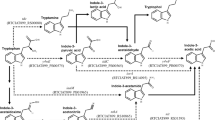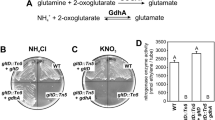Abstract
We have previously reported detection of significant pyrroloquinoline quinone-linked glucose dehydrogenase activity in Sinorhizobium meliloti cells isolated from alfalfa (Medicago sativa L.) nodules. In this work, we report the expression of the gcd gene (SMc00110) during root nodule development and characterize the symbiotic phenotype of S. meliloti gcd mutant RmH580. Using a S. meliloti strain carrying a gcd–lacZ transcriptional fusion, gcd expression was detected from very early stages of plant–bacteria interactions, at the rhizosphere level, and during further stages of nodule development. Alfalfa plants inoculated with RmH580 showed a delay in nodule emergence and a reduced ability for nodulation at various inoculum dosages. RmH580 was also deficient in its competitive ability; in coinoculation experiments a mutant:wild-type inoculum ratio higher than 100:1 was necessary to obtain an equal ratio of nodule occupancy. These results indicate that PQQ-linked glucose dehydrogenase is required by S. meliloti for optimal nodulation efficiency and competitiveness on alfalfa roots.




Similar content being viewed by others
References
Ameyama M, Nonobe M, Shinagawa E, Matsushita K, Takimoto K, Adachi O (1986) Purification and characterization of the quinoprotein D-glucose dehydrogenase apoenzyme from Escherichia coli. Agric Biol Chem 50:49–57
Barsch A, Patschkowski T, Niehaus K (2004) Comprehensive metabolite profiling of Sinorhizobium meliloti using gas chromatography–mass spectrometry. Funct Integr Genomics 4:219–230
Bernardelli CE, Luna MF, Galar ML, Boiardi JL (2001) Periplasmic PQQ-dependent glucose oxidation in free-living and symbiotic rhizobia. Curr Microbiol 42:310–315
Bhuvaneswari TV, Turgeon BG, Bauer WD (1980) Early events in the infection of soybean (Glycine max L. Merr) by Rhizobium japonicum. I. Localization of infectible root cells. Plant Physiol 66:1027–1031
Boiardi JL, Galar ML, Neijssel OM (1996) PQQ-linked extracellular glucose oxidation and chemotaxis towards this cofactor in rhizobia. FEMS Microbiol Lett 140:179–184
Caetano-Anollés G, Bauer WD (1988) Enhanced nodule initiation on alfalfa by wild-type Rhizobium meliloti co-inoculated with nod gene mutants and other bacteria. Planta 174:385–395
Caetano-Anollés G, Favelukes G, Bauer WD (1990) Optimization of surface sterilization for legume seed. Crop Sci 30:708–712
Cozier GE, Salleh RA, Anthony C (1999) Characterization of the membrane quinoprotein glucose dehydrogenase from Escherichia coli and characterization of a site-directed mutant in which histidine-262 has been changed to tyrosine. Biochem J 340:639–647
Dymov IS, Meek D, Steven B, Driscoll B (2004) Insertion of transposon Tn5tac1 in the Sinorhizobium meliloti malate dehydrogenase (mdh) gene results in conditional polar effects on downstream TCA cycle genes. Mol Plant Microbe Interact 17:1318–1327
Evans C, Herbert D, Tempest DW (1970) The continuous cultivation of micro-organisms. 2. Construction of a Chemostat. Methods Microbiol 2:277–327
Fahraeus G (1957) The infection of clover roots hairs by nodule bacteria studied by a simple glass slide technique. J Gen Microbiol 16:374–381
Fraysse N, Couderc F, Poinsot V (2003) Surface polysaccharide involvement in establishing the rhizobium–legume symbiosis. Eur J Biochem 270:1365–1380
Fry J, Wood M, Poole PS (2001) Investigation of myo-inositol catabolism in Rhizobium leguminosarum bv. viciae and its effect on nodulation competitiveness. Mol Plant Microbe Interact 14:1016–1025
Glazebrook J, Walker GC (1989) A novel exopolysaccharide can function in place of calcofluor-binding exopolysaccharide in nodulation of alfalfa by Rhizobium meliloti. Cell 56:661–672
Gosselin I, Wattraint O, Riboul D, Barbotin J, Portais J (2001) A deeper investigation on carbohydrate cycling in Sinorhizobium meliloti. FEBS Lett 499:45–49
Hommes R, Van Hell B, Postma P, Neijssel OM, Tempest D (1985) The functional significance of glucose dehydrogenase in Klebsiella aerogenes. Arch Microbiol 143:163–168
Jiang G, Krishnan AH, Kim YM, Wacek TJ, Krishnan HB (2001) A functional myo-inositol dehydrogenase gene is required for efficient nitrogen fixation and competitiveness of Sinorhizobium fredii USDA191 to nodulate soybean (Glycine max [L.] Merr.). J Bacteriol 183:2595–2604
Krishnan H, Kim W, Sun-Hyung J, Kim K, Jiang G (2003) Citrate synthase mutants of Sinorhizobium fredii USDA257 form ineffective nodules with aberrant ultrastructure. Appl Environ Microbiol 69:3561–3568
Lodwig E, Poole P (2003) Metabolism of Rhizobium bacteroids. CRC Crit Rev Plant Sci 22:37–78
Luna MF, Bernardelli CE, Mignone CF, Boiardi JL (2002) Energy generation by extracellular aldose oxidation in N2-fixing Gluconacetobacter diazotrophicus. Appl Environ Microbiol 68:2054–2057
McDermott T, Kahn M (1992) Cloning and mutagenesis of the Rhizobium meliloti isocitrate dehydrogenase gene. J Bacteriol 174:4790–4797
Meade HM, Long SR, Ruvkun GB, Brown SE, Ausubel FM (1982) Physical and genetic characterization of symbiotic and auxotrophic mutants of Rhizobium meliloti induced by transposon Tn5 mutagenesis. J Bacteriol 149:114–122
Oresnik IJ, Pacarynuk LA, O’Brien SAP, Yost CK, Hynes MF (1998) Plasmid-encoded catabolic loci in Rhizobium leguminosarum bv. trifolii. Evidence for a plant-inducible rhamnose utilisation locus involved in competition for nodulation. Mol Plant Microbe Interact 11:1175–1185
Pellock B, Cheng H, Walker G (2000) Alfalfa root nodule invasion efficiency is dependent on Sinorhizobium meliloti polysaccharides. J Bacteriol 182:4310–4318
Poole P, Allaway D (2000) Carbon and nitrogen metabolism in Rhizobium. Adv Microb Physiol 43:117–163
Portais J, Tavernier P, Besson I, Courtois J, Courtois B, Barbotin J (1997) Mechanism of gluconate synthesis in Rhizobium meliloti by using in vivo NMR. FEBS Lett 412:485–489
Romanov V, Hernández-Lucas I, Martínez-Romero E (1994) Carbon metabolism enzymes of Rhizobium tropici cultures and bacteroids. Appl Environ Microbiol 60(7):2339–2342
Schäfer A, Tauch A, Jäger W, Kalinowski J, Thierbach G, Pühler A (1994) Small mobilizable multi-purpose cloning vectors derived from the Escherichia coli plasmids pK18 and pK19: selection of defined deletions in the chromosome of Corynebacterium glutamicum. Gene 145:69–73
Spaink HP, Okker R, Wijffelman C, Pees E, Lugtenberg B (1987) Promoters in the nodulation region of the Rhizobium leguminosarum Sym plasmid PRLIJI. Plant Mol Biol 9:27–39
Streeter J (1991) Transport and metabolism of carbon and nitrogen in legume nodules. Adv Bot Res 18:129–187
Streeter J (1995) Recent developments in carbon transport and metabolism in symbiotic systems. Symbiosis 19:175–176
Teeri T, Lehväslaiho H, Franck M, Uotila J, Heino P, Palva E et al (1989) Gene fusion to lacZ reveal new expression patterns of chimeric plants. EMBO J 8:343–350
Vincent JM (1970) A manual for the practical study of the root-nodule bacteria. Blackwell, Oxford
Walshaw D, Wilkinson M, Mundy M, Smith M, Poole P (1997) Regulation of the TCA cycle and the general amino acid permease by overflow metabolism in Rhizobium leguminosarum. Microbiology 143:2209–2221
White J, Prell J, James EK, Poole P (2007) Nutrient sharing between symbionts. Plant Physiol 144:604–614
Acknowledgments
We thank Prof. J. Streeter for critically reviewing the manuscript and Prof. T. Finan for providing the strains. J.L. Boiardi is member of CONICET (Consejo Nacional de Investigaciones Científicas y Técnicas).
Author information
Authors and Affiliations
Corresponding author
Additional information
Responsible Editor: Hans Lambers.
Electronic supplementary material
Below is the linked to the electronic supplementary material.
Table A
Shoot dry weight and fresh nodule mass of plants inoculated with S. meliloti RCR2011, 1021 and their derived gcd mutants (PDF 19 kb)
Rights and permissions
About this article
Cite this article
Bernardelli, C.E., Luna, M.F., Galar, M.L. et al. Symbiotic phenotype of a membrane-bound glucose dehydrogenase mutant of Sinorhizobium meliloti . Plant Soil 313, 217–225 (2008). https://doi.org/10.1007/s11104-008-9694-1
Received:
Accepted:
Published:
Issue Date:
DOI: https://doi.org/10.1007/s11104-008-9694-1




